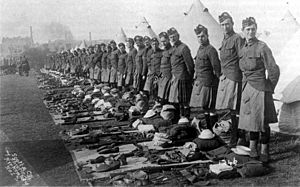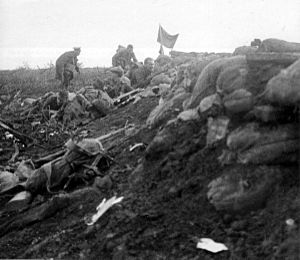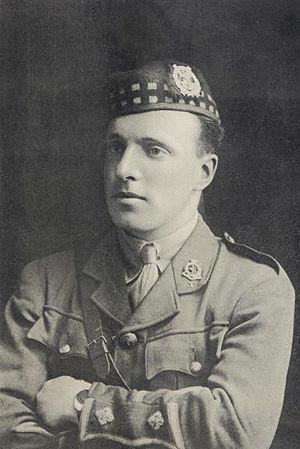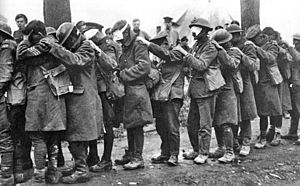Liverpool Scottish facts for kids
Quick facts for kids Liverpool Scottish |
|
|---|---|
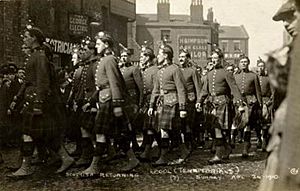
The Liverpool Scottish, 24 April 1910.
|
|
| Active | 1900–2014 |
| Country | |
| Branch | |
| Type | Territorial Army |
| Role | Infantry |
| Size | Platoon |
| TA Centre | Townsend Avenue, Norris Green |
| Uniform | Glengarry, with blue hackle |
| March | The Glendaruel Highlanders Quick March: Loch Rannoch |
| Engagements | Second Boer War First World War Second World War |
| Decorations | Victoria Cross: Captain N.G. Chavasse |
| Battle honours | South Africa 1902 The Great War: Bellewaarde, Somme 1916, Ginchy, Morval, Ypres 1917, Pilckem, Menin Road, Passchendaele, Cambrai, Lys, Estaires, France and Flanders 1914–18 |
| Insignia | |
| Tartan |  Clan Forbes tartan |
| Hackle | Royal Blue |
The Liverpool Scottish was a special unit of the British Army. It was part of the Army Reserve, which used to be called the Territorial Army. This unit was formed in 1900 as a group of infantry soldiers (foot soldiers).
The Liverpool Scottish was known for its Scottish traditions. It later joined the Queen's Own Cameron Highlanders regiment. Over the years, the unit became smaller. By 2006, it was part of the 4th Battalion, Duke of Lancaster's Regiment.
The Liverpool Scottish played a big part in the First World War. It was one of the first volunteer units to go to the Western Front in November 1914. Sadly, about 1,000 of the more than 10,000 men who served with the Scottish died during that war.
One of the most famous soldiers from the unit was Captain Noel Chavasse. He was given two Victoria Crosses, which are the highest awards for bravery. He is one of only three people ever to receive this award twice.
During the Second World War, the Liverpool Scottish grew to two battalions (larger groups of soldiers). They didn't serve abroad as whole units. Instead, their soldiers joined other battalions and special forces called Army Commandos. These commandos fought in places like Norway and took part in the daring St Nazaire Raid. The Liverpool Scottish unit finally ended its long history on April 30, 2014.
Contents
Forming the Liverpool Scottish (1900–1914)
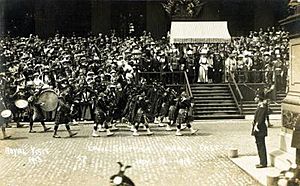
Before 1900, there was an attempt to create a Scottish unit in Liverpool. This happened in the late 1850s because of rising tensions with France. Several "Scottish" companies were formed, but they broke apart due to disagreements.
However, the Second Boer War (1899-1902) sparked new interest in forming a Scottish unit in Liverpool. So, on April 30, 1900, the 8th (Scottish) Volunteer Battalion was officially created. It became part of the King's (Liverpool Regiment).
The Liverpool Scottish was one of only four battalions in English regiments that focused on Irish and Scottish communities. The soldiers wore traditional highland clothes. This included the Clan Forbes pattern tartan (a special checked fabric) and the glengarry hat.
Serving in the Boer War
Like other volunteer battalions, the Liverpool Scottish sent a group of 22 volunteers to fight in South Africa during the Second Boer War in 1902. They joined the 1st Gordon Highlanders. Their main job was to guard blockhouses, which were small forts. The war was almost over by then.
Even though their duties were limited, the British Army recognized their help. The battalion was given a special award called a battle honour: "South Africa 1902." This showed their bravery and service.
In 1904, the Liverpool Scottish got its own special building for its headquarters in Liverpool City Centre. This building was paid for partly by public donations and a big event called a "bazaar."
In 1908, the unit became the King's 10th Battalion. This was part of changes that created the Territorial Force. This force brought together volunteers and cavalry units into larger groups. By 1914, the 10th (Liverpool Scottish) was part of the West Lancashire Division.
The First World War (1914–1918)
Early Days and First Battles (1914–1915)
When the First World War started in August 1914, the Liverpool Scottish got ready for battle. They moved to Scotland to help defend the Firth of Forth. Two more battalions were formed in Liverpool for soldiers who couldn't go overseas. These new battalions trained recruits and sent new soldiers to the front lines.
The original 1/10th battalion was considered well-trained. It was the seventh volunteer battalion sent to the Western Front. They sailed from Southampton on November 1, 1914. These original soldiers were later known as the "Maidaners," after their ship.
The battalion was sent to the Kemmel area, near Ypres in Belgium. Their first soldier died on November 29. The harsh winter and trench warfare quickly made many soldiers sick or wounded. By January 1915, the battalion had only 370 fit men out of over 800.
The soldiers also had to deal with old equipment. Their rifles were outdated compared to the regular army's. These older rifles were slowly replaced in 1915 and 1916. Also, the volunteer battalions were organized differently from the regular army. They had to change their structure to match, going from eight companies to four.
The Battle of Hooge (1915)
The battalion's first major battle was on June 16, 1915, at Hooge, about 2 miles (3.2 km) east of Ypres. The goal was to attack German trenches and reach Bellewaarde Lake. This was to keep German soldiers busy while other Allied forces fought elsewhere.
At 4:15 AM, the first wave of British troops attacked. The Liverpool Scottish and the 1st Lincolnshire Regiment followed in the second wave. They moved through the first attackers to reach the German second line of trenches. Even though the advance was mostly smooth, one company of the Scottish faced heavy machine-gun fire. They charged and captured about 40 German prisoners.
However, the battle quickly became very messy. British units got mixed up. Intense German shelling hit the second-line trenches hard. The Liverpool Scottish's temporary commander was wounded. Some Scottish soldiers even pushed beyond the third line, heading towards a dangerous area called Dead Man's Bottom.
The Scottish eventually had to retreat to the former German frontline. The battle continued into the night. For gaining about 1,000 yards (3,000 ft) of land, the Liverpool Scottish suffered huge losses: 79 killed, 212 wounded, and 109 missing. A memorial was built in 2000 to remember this battle.
The Somme and Ypres (1916–1917)
In January 1916, the Liverpool Scottish joined the 55th (West Lancashire) Division. In July 1916, they moved to the Somme Offensive. They spent six days under constant artillery fire. Then, they prepared to attack the village of Guillemont. This village had already been attacked twice.
On August 8, the attack on Guillemont began. It failed, and many soldiers were lost. The Liverpool Scottish, which had been in reserve, was ordered to attack the next day. They had to advance about 400 yards (1,200 ft) and capture the German frontline.
The battalion faced many problems, including getting to their starting positions in the dark. A five-minute artillery bombardment came before the attack. At 4:20 AM, the Liverpool Scottish attacked. They were caught in the German artillery fire and machine-gun fire. Their progress was stopped.
Their commander, Colonel Davidson, tried to rally his soldiers but was wounded. Two more attempts to reach the German frontline failed. Most soldiers were stopped by uncut barbed wire. Out of about 600 soldiers, 74 were killed, 174 wounded, and 32 were missing.
During this battle, Captain Noel Godfrey Chavasse was attached to the Liverpool Scottish. He was awarded the Victoria Cross for his bravery. He was the first and only soldier from the Liverpool Scottish to receive this highest award. He had also received the Military Cross earlier at Hooge.
After the Somme, the battalion helped build trenches and bury the dead. In October, they moved to the quieter Ypres Salient. They stayed there until the Third Battle of Ypres in July 1917.
On July 31, 1917, a new attack was launched around Ypres. The Liverpool Scottish faced very strong resistance and suffered heavy losses. Captain Chavasse died of his wounds the next day after helping wounded soldiers again. His actions earned him a second Victoria Cross, making him one of only three men to receive it twice.
In September, the Scottish moved south to Epehy. In November, their division took part in the Battle of Cambrai.
The Final Year (1918)
On March 21, 1918, Germany launched a huge attack called Operation Michael. This was their last big effort to win the war. The Liverpool Scottish and their division joined the fight in April during the next phase, Operation Georgette.
This attack focused on the town of Ypres. The Germans used a massive bombardment, including phosgene gas shells. This caused many casualties among the Liverpool Scottish.
The Liverpool Scottish defended the Givenchy area during the Battle of Estaires. They lost so many soldiers that they had to combine with the 2/10th Battalion. After the German attack was stopped, the Allies began their own attacks from August to November. This was known as the Hundred Days Offensive.

The Liverpool Scottish fought one of its last battles of the war at La Bassée Canal in October. In the days leading up to the Armistice of 11 November 1918, the Liverpool Scottish helped secure many villages. On November 9, they crossed the River Scheldt.
On Armistice Day, November 11, 1918, the Liverpool Scottish was ready to attack the town of Ath. But the attack was stopped when another unit captured a bridge before it could be destroyed.
After the war, many Liverpool Scottish soldiers who couldn't go home right away were sent to Antwerp. They helped manage a camp for soldiers returning to England. They stayed there until their job was done in November.
Between the World Wars
After the war, the Liverpool Scottish became part of the Territorial Army again in 1920. They officially joined the Queen's Own Cameron Highlanders in 1937. Even though they became part of a Scottish regiment, they kept their unique identity. Their headquarters remained in Liverpool.
In 1938, King George VI visited Liverpool. He presented the battalion with new colours (special flags) at Everton Football Club's Goodison Park stadium.
The Second World War
In March 1939, the Territorial Army started to grow. The Liverpool Scottish formed a second battalion. Both battalions were ready when the Second World War began in August 1939. They stayed in Britain for the whole war.
However, soldiers from both battalions were sent to other units, especially the Cameron Highlanders. They also formed groups for the new "Independent Companies," which later became the Army "Commandos".
Liverpool Scottish Commandos
The Liverpool Scottish sent a group of soldiers to No. 4 Independent Company. This company was formed on April 21, 1940. Soon after, they sailed to Norway to join the Allied fight against Germany. They landed in early May and took up positions near Mosjoen.
On May 11, German forces cut off Mosjoen. No. 4 Company had to be evacuated by a Norwegian ship. They were taken to Sandnessjøen and then to Bodø. By May 24, Allied troops had set up defenses near Pothus to protect Bodø.
However, the British Government decided to pull out of northern Norway. The Allied forces began to leave on May 29. The Liverpool Scottish soldiers returned to Britain.
After returning, the Liverpool Scottish soldiers in the Commandos were allowed to wear the kilt again as part of their uniform. Later in 1940, the Commando units were combined into "Special Service" battalions. But this system wasn't popular. In 1941, the battalions were split again into separate Commando units. The Liverpool Scottish soldiers became part of 5 Troop in No. 2 Commando.
The St Nazaire Raid (1942)
In March 1942, the troop from the Liverpool Scottish took part in the famous St Nazaire Raid. This operation was called "Operation Chariot." Its goal was to destroy the port of St Nazaire in France. This port was a safe place for the German battleship Tirpitz in the Atlantic.
The raid involved 611 men, an old destroyer called Campbeltown, and many small boats. The Campbeltown was changed to look like a German destroyer. It was also packed with 9,600 pounds (4,400 kg) of explosives. The raid was a daring and dangerous mission.
Anti-Tank Regiment
On November 1, 1942, the 2nd Battalion of the Liverpool Scottish was changed. It became the 89th (Liverpool Scottish) Anti-Tank Regiment in the Royal Artillery. This unit had special batteries (groups of guns) to fight enemy tanks.
This regiment became part of the 47th (London) Infantry Division in November 1943. This division was used for training and reserves. After the war, the 89th Anti-Tank Regiment was slowly closed down by April 1946.
After the War
The 1st Battalion (Post-War)
When the Territorial Army was reformed on January 1, 1947, the 1st Battalion of the Liverpool Scottish was also reformed. It was called the 1st (Motor) Battalion, Liverpool Scottish, Queen's Own Cameron Highlanders.
In the 1960s, the Territorial Army was reorganized. Many battalions were reduced in size or closed. The Liverpool Scottish avoided being completely disbanded. Instead, it was split into two separate units:
- V (Liverpool Scottish) Company of the 51st Highland Volunteers (infantry)
- G (The Liverpool Scottish) Troop of R (King's) Battery, The West Lancashire Regiment Royal Artillery (artillery)
Both units kept their headquarters in Liverpool. The artillery troop was later absorbed by another unit in 1974. The infantry company remained part of the 51st Highland until 1992.
In 1974, during training in Cyprus, the Liverpool Scottish soldiers were caught up in a conflict on the island. They were safely evacuated to a British base.
Later, "V" Company became part of the 5th/8th (Volunteer) Battalion of the King's Regiment. In 1999, the Scottish was reduced even further to 2 (The Liverpool Scottish) Platoon. This platoon moved to Townsend Avenue in Norris Green, where other Liverpool infantry units are based.
In 2006, the King's Regiment joined with two others to form the Duke of Lancaster's Regiment. The Liverpool Scottish Platoon remained part of this new regiment. Soldiers from the platoon served in places like Bosnia, Afghanistan, and Iraq.
The long history of the Liverpool Scottish finally ended on April 30, 2014. The last remaining platoon was disbanded. Its soldiers then fully joined the Duke of Lancaster's Regiment.
Anti-Aircraft Regiment (Post-War)
The 2nd Battalion of the Liverpool Scottish also reformed after the war. On January 1, 1947, it became the 655 (Liverpool Scottish) Light Anti-Aircraft/Searchlight Regiment. This unit helped defend against enemy aircraft.
However, on July 22, 1950, it was merged into another unit in Liverpool. The soldiers of the 655 (Liverpool Scottish) LAA/SL Regiment wore a special patch on their uniform. It was a rectangle of Forbes tartan on their left shoulder. This tradition was continued by the Liverpool Scottish battery in the new unit.
Commanding Officers
| Name | Rank | Years in Command | Notes |
|---|---|---|---|
| Christopher Forbes Bell | Lieutenant-Colonel | 1900–1902 | Resigned due to health |
| Andrew Laurie Macfie, CB, VD, DL | Lieutenant Colonel | 1902–1911 | Later a brigadier-general |
| William Nicholl | Lieutenant-Colonel | 1911–1914 | Replaced due to age |
| George Alexander Blair | Major | 1914 | Replaced due to health |
| Jonathan Roberts Davidson, CMG | Lieutenant-Colonel | 1914–1916 | Wounded at Guillemont |
| F.W.M. Drew, DSO | Lieutenant-Colonel | 1916–1917 | Later commanded 9th Battalion, King's Regiment |
| Sir Jonathan Roberts Davidson, CMG | Lieutenant-Colonel | 1917 | Chief Engineer for the City of Liverpool |
| James Leslie Auld Macdonald, DSO | Lieutenant-Colonel | 1917–1918 | From the Royal Scots |
| David Campbell Duncan Munro, DSO, MC, DCM | Lieutenant-Colonel | 1918–1919 | From the Gordon Highlanders |
| Edward Gordon Thin, DSO | Lieutenant-Colonel | 1920-1921 | Helped reform the battalion |
| George Bentham Leathart Rae, DSO, TD | Lieutenant-Colonel | 1921-1923 | |
| Sir Arthur Alexander Gemmell, MC, TD | Lieutenant-Colonel | 1923-1927 | |
| George Bentham Leathart Rae, DSO, TD | Lieutenant-Colonel | 1927-1930 | |
| Benjamin Arkle, MC | Lieutenant-Colonel | 1930-1932 | |
| Archibald M. McGilchrist, TD | Lieutenant-Colonel | 1932-1936 | Wrote the battalion's history |
| I.R.T. Irvine | Lieutenant-Colonel | 1936-1938 | |
| F.W. McGuinness | Lieutenant-Colonel | 1938-1940 | |
| H.J.D.L. McGregor | Lieutenant-Colonel | 1940-1942 | From Cameron Highlanders |
| C.B. Mackenzie | Lieutenant-Colonel | 1942 | Took command of 5th (Scottish) Parachute Battalion |
| R.P. Haig | Lieutenant-Colonel | 1942-1943 | |
| J.R. Paterson | Lieutenant-Colonel | 1943- | Commanded No. 4 Independent Company |


